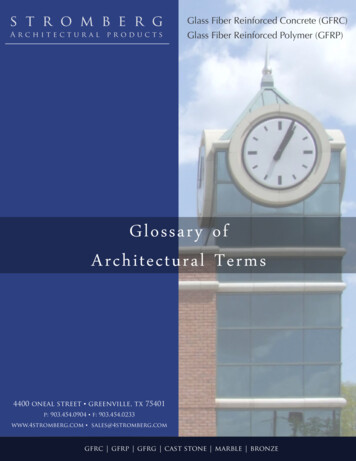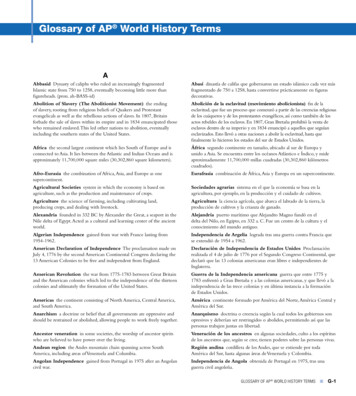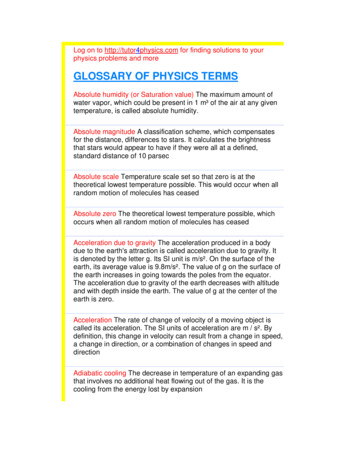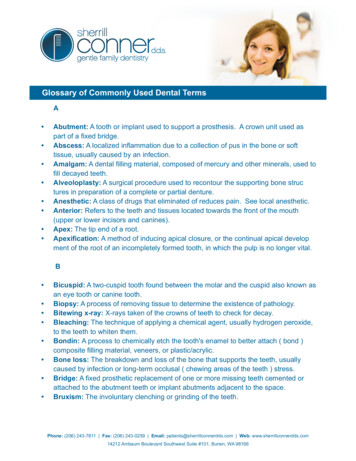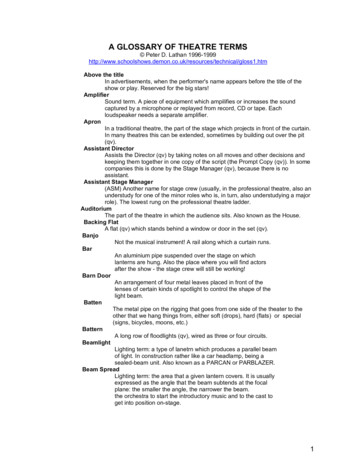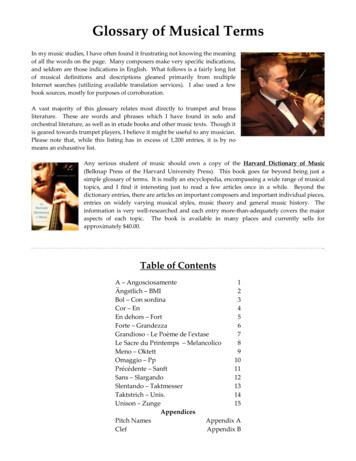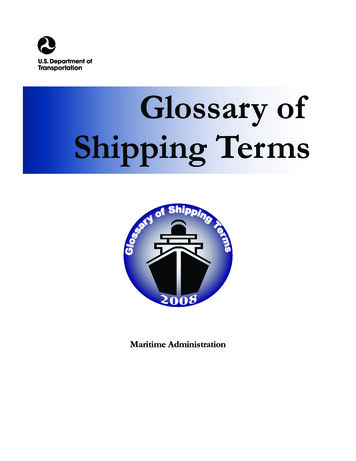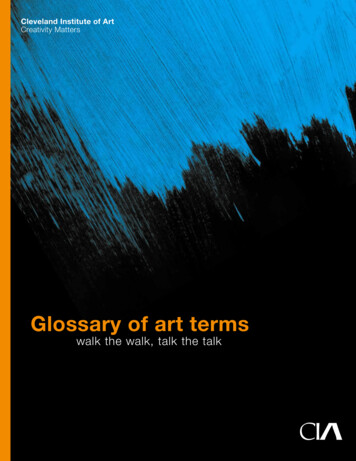
Transcription
Cleveland Institute of ArtCreativity MattersGlossary of art termswalk the walk, talk the talk1
Aestheticsthe study or theory of “beauty” and of the psychologicalresponses to it; specifically, the branch of philosophydealing with art, its creative sources, its forms, and itseffectsBalancea feeling of equal weight, attention, or attraction of visualelements within an artwork1. the hidden structure and relationship of elementswithin a work, giving it stability, tension, excitement,or equilibrium. Individual relationships may beunbalanced but balance may exist within the totalstructure.2. a feeling of equality in weight, attention, or attractionof the various elements within the pictorial fieldCommunitya feeling of fellowship with others, as a result ofsharing common attitudes, interests, goals, or acommon culture.Compositionthe organizing of elements of an artwork into aunified whole; the arrangement of pictorial elementsin a picture planeConcept/conceptualthe idea underlying a work of art or design; the meaningof a creative work; sometimes seen in comparison toForm (see Form)ContextChiaroscuroeffect of blending light and shade on objects to createthe illusion of 3D (three-dimensionality), or volumeChroma1. purity or intensity of a color2. refers to the range from pure, full-strengthpigments to dull, muted pigments reduced by theaddition of white, black, gray, or another colorCliché1. originally, a stereotype printing plate2. an expression or idea that has become trite, or wornout by constant useCollaborationthe action of working with someone(or as a member of a team) to produce orcreate something2The circumstances that create the setting for an event,statement, or idea, and in terms of which it can be fullyunderstood and assessed. Art is often described asbeing part of its social or historical context. That is, aspart of the culture and period of its makingCraftsmanshipEverything from attention to detail, to sensitivitywith materials, and the appropriateness of the form things to look at and think about in relation to howwe make things; the ability to produced well-madeobjects and imagesCritique1. a critical analysis or evaluation of a subject, situation,literacy work, etc.2. the act or art of criticizing.3. “ period for the student to get up and talk abouthis/her work a critique can be formal or informal it’s a period in which we stop and review what hasbeen done ”Purpose: open discussion directed towardassessing the strengths and weaknesses of thework being viewed
Asymmetrical/Symmetrical BalanceAsymmetrical:a form of balance createdwhen visual units areplaced in different positionswithin the picture, creatinga sense of equilibrium,without repeatingplacement of units withrespect to the central axisSymmetrical:a form of balanceinwhich each halfof an image is a mirrorreflection of the other half.3
Contour1. in art, the outer edge of anobject or shape that is mostoften defined by line, but canbe defined by value, texture,color, and mass2.outline, borderline, orcontainment of a form, 2-Dor 3-D
Gesturalused to describe a quality of expressive movement,often a loose, energetic qualityDepict1. to represent, describe in a drawing, painting,sculpture, etc; portray, picture2. to picture in words or imagesDesignthe process of structuring a coherent field ofrelationships which are imaginative and visuallyinterestingDominance/Dominant1. principal of visual organization which suggests someelements are more important than others in the samecomposition2. the most influential or conspicuous aspector element of a workDynamicactive quality conveyed by a sense of movementbetween the elementsEnergy1. implied movement2. the gestural nature of the materials as it provides asense of the process as a physical oneFigure/GroundFigure:1. in two-dimensional and three-dimensional arts, arepresentation of the human body2. in design, any pattern or repeated decorativemotif, as in figured textiles positive shape or form3. any shape that represents an objectForeshorteningthe reduction or diminishing of the dimensions, usuallylength, of an object of figure in order to present it in thecorrect spatial relationshipForm/formal1. the shape, outline, or configuration of any structureas apart from color, material, etc.2. the body or figure of a person or animal/a model of ahuman figure3. anything used to give shape to something else; mold4. arrangement; esp. orderly arrangement;way in which parts of a whole are organized5. the organization of all the elements that give the workexpression /consideration of visual elements of awork regardless of subject concept or statement;(see Concept)Gestaltthe phenomenon that causes images to be perceivedas unified wholes before they are perceived as parts.For example, a human face is seen as a whole unit priorto seeing/perceiving the individual components (ear,nose, etc.Ground1. a surface to which paint is applied; also, a coatingmaterial used to prepare a surface for painting2. in relief sculpture, the flat surface from which figuresproject usually, the negative space or shape.Ground:The area around the figure, sometimes referred toas the “background”5
Geometric ShapeA shape that appears related to geometry.Geometric shapes are usually simple,such as the triangle, the rectangle, thepentagon, and the circle.Hue (color)1. a pure color, the quality of a color2. the common name of a color(i.e. red, yellow, blue)3. hue also implies the temperature of a colorIllusory Spacethe imitation or visual reality created on a flat surface bythe use of perspective, light and dark shading, etc.Image1. an imitation of representation of a person or thing,drawn, painted, or photographed, etc., esp. a statue2. a mental picture of something; conception,idea,impression3. a vivid representation, graphic depictionLocal Colorthe natural color of an object as understood by themind; i.e. green grass, blue skyMonochromatichaving only one hue, but varying in value and/or chromaMovementan implied visual sensation through repetition of anelement or through a progressive change of an elementOrganic Shapefree-flowing, curvilinear shapes frequently occurringin naturePainterlyINterpretation1. the expression of a person’s conception of a work ofart, subject, etc., through acting, playing, writing, orcriticizing2. the act or result of explaining, translating, etc.1. having the quality of expertly brushed workmanship2. a term applied to the dominance of tonal massesover line as a means of defining form in architecture,painting and sculpture. Edvard Munch’s The Screamis an example of a painterly stylePatternIterative processA process for arriving at a decision or a desired result byrepeating rounds of analysis or a cycle of operations.For example, in class a student’s work may be reviewedby the faculty member and others in the class and thenthe work is reconsidered based on that feedbackLine qualitythe sensitivity and control of line variation to expressparticular visual characteristicsLinear Perspectivethe drawing of objects in line to suggest their threedimensionality and their existence in space6repetition of an element or a motif, and/or the emphasisof directional movementsPerspectiveDepiction of three-dimensional objects and spatialrelationships on a two-dimensional plane. In Westernart, illusions of volume and space are generally createdby use of the linear perspective system, based on theobservation that objects appear to shrink and parallellines to converge at an infinitely distant vanishing pointas they recede in space from the viewer.Picture PlaneThe surface area of a drawing, painting, print, etc.
Rhythmsensation of orderedmovement implied byrepetition and variation ofvisual elements in a work7
Positive/NegativeSpacePositive Space:space implying an objectNegative Space:space surrounding a objector between objects(Positive/Negative Spacecan also refer to the Figure/Ground relationship (seeFigure/Ground)
Planarcharacteristic of an image being formed by planes inrelation to one anotherPlanea shape that is 2-D and therefore has height and widthPlastic1. synthetic material2. 3-D form, sculpture (plastique)3. 2-D form that gives the illusion of sculptural realityPortrayal1. to make a picture or portrait; depict; delineate2. to make a word picture of; to describe graphically3. An artist’s individual rendition of an object of themeProcessa particular method of doing something, generallyinvolving a number of steps or operationsProportioncomparison of elements in terms of their relative size,or quantityRender1. to represent; depict; specifically to make a drawingin perspective2. to express in other words, ways; especiallyto translateRepresentationa (visual) description or statement of factsScalethe relative size of an art work or a component withinan artwork.Shading(verb) the subtle blending of one color into anotherShape(2-D): an area that stands out because of a definedboundary or because of a difference in value, color,or texture(3-D): refers to a solid or the illusion of a solid; a shapehaving height, width, depth, i.e. geometric, organicshapeSpace1. (in 2-D works) may refer to the distance betweenpoints on the surface2. the implied receding distance from the viewer3. the illusion of spaceStaticwhen an element or composition is motionlessStylizedrepresentation of natural forms which deals with artisticideals or conventions more than observationSYMBOLA shaped used to represent something abstract; ashape that arouses in the viewer’s mind a general, yetuniversally accepted conceptTechniquethe manner and skill with which artists use their toolsand materials; an artist’s technique can affect theaesthetic and concept of an artwork, and may reveal acertain styleTension1. the visual pulling, straining between any number ofpoints in a composition2. the balance that is maintained between opposingvisual forces9
TextureWashthe actual and visual feel of surface areasValue Contrastopposing degrees of lightness or darkness;i.e. black & whiteVolume1.2.a 3-D shape that occupies a quantity of spaceimplied sense of mass through modeling of formWarm/Cool contrastsWith similar hues:red: red-orange (warm) red–violet (cool)blue: blue-violet (warm) blue-green (cool)Contrasting hues:blue (cool) – orange (warm)green (cool) – red (warm)Complementary color scheme10Analogous color schemean application of dilute material (as oil, acrylic,watercolor, etc.) to the paper or canvasWeightvisual importance that an element, (color, pattern, etc.),carries in a composition
Value Scalethe sequence of values whichallows us to measure thelightness or darkness of anobject11
Cleveland Institute of Art11141 East BoulevardCleveland OH 44106800.223.4700cia.edu
the imitation or visual reality created on a flat surface by the use of perspective, light and dark shading, etc. ImAGe 1. an imitation of representation of a person or thing, drawn, painted, or photographed, etc., esp. a statue 2. a mental picture of something; conception,idea, impression 3. a vivid representation, graphic depiction Interpret AtIon 1. the expression of a person’s conception of a work ofFile Size: 1MBPage Count: 12

